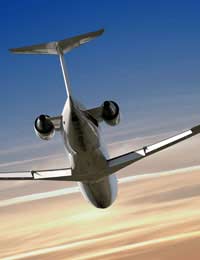What Keeps Such a Heavy Machine in the Air?

The take-off weight of a typical modern mid-range aircraft is around 50000kg. This is 50 times the weight of an average family car and about 20000 times the weight of the heaviest bird! It is not surprising that many people wonder how such a heavy machine is able to stay in the air, let alone be able to take-off from the ground.
Most of the weight is made up from the aircraft itself. Added to that, there are passengers, their baggage, enough fuel to reach the destination and, of course, food and drink for the passengers.
Thrust and Lift
So how does such a heavy structure manage to stay up?A combination of forces help aircraft stay in flight. Firstly, there is thrust from the engines. This propels the aircraft at speeds up to 800 miles per hour. But of course, more than just speed is needed to keep the aircraft flying.
The second important aspect of flying is lift. Aircraft wings are specially designed to maximise lift. The top surface of the wing is more curved than the underneath. This causes air flowing over the top of the wing to speed up and travel faster than the air flowing underneath the wing. Faster moving air always has a lower pressure than slower air, thus a pressure difference occurs between the top of the wing and the bottom. The wing is pushed up, from the high pressure area into the low pressure area.
Controlling Altitude
Due to the design of the aircraft’s wing, which is aimed at maximising lift, it might be thought that an aircraft should constantly rise in altitude – because it keeps getting lift from the faster moving air over the top of the wing. Indeed, if left uncontrolled the aircraft would continue to rise, but for one clever addition to the controls. Small hinged surfaces at the rear of the tail plane, the mini wing structure at the back of the fuselage, allow pilots to control the amount of lift that is transmitted by the aircraft. These devices, called elevators, push up the tail, resulting in the nose being kept at the correct altitude. Small tabs on the ends of the elevators, called trim tabs, are used to trim the aircraft for straight and level flight. On modern aircraft, trim tabs are controlled by the on-board computer, keeping the aircraft perfectly steady at the altitude programmed by the pilots.Lessons from Nature
Aircraft engineers have taken lessons from nature. Birds that fly long distances, such as albatrosses and eagles, have wings with high aspect ratios. This is simply the ratio between the length of the wing and its breadth. The size of aircraft wings is an important consideration when calculating if it will stay up or not. Careful consideration is given to the design of wings so that stability and endurance are optimised. These technical calculations ensure that enough wing area is exposed to moving air to keep such a heavy machine flying for hours at a time.- How Many Planes Are There in the Sky?
- Environmental Facts About the Air Travel Industry
- Why Aircraft Engines Don't Fail
- How Pilots Train for all Possible Scenarios
- Aircraft: What are all the Checks For?
- What Are Those Noises Inside the Aircraft?
- Why is Turbulence Not Usually Dangerous?
- Doors to Automatic: What is That all About?
- How Do Aircraft Fly?


Re: Why Some People Have a Fear of Flying
A hydrofoil with a hull Is primitive, rather dull; Must not it sink Should engines kink? Airplanes crash and crack…
Re: Aerophobia Clinics and Courses
I am absolutely petrified of flying however I have agreed to fly in July to Spain. I am flying with my two young children, both…
Re: Anxiety Medication
Please help I'm absolutely terrified of flying and I go away in two wks , I really don't know how I'm going to cope I have tryed diazepam in…
Re: What Causes The Fear of Flying?
My 13 year old daughter is now so afraid of flying that we were unable to go on our last holiday in March. We arrived at the…
Re: How I Overcame My Fear of Flying: A Case Study
At Southport we were flying to Ostend in a Bristol44 aircraft It taxied along the runway ,just before…
Re: Doors to Automatic: What is That all About?
Very good I've always wondered what Doors to automatic and cross check means
Re: What is Aerophobia?
i dont have aerophobia but sky phobia…
Re: Hypnosis and Fear of Flying
The difficulty with phobias is that there are often underlying problems so that one phobia reveals another and so on. General…
Re: Why is Turbulence Not Usually Dangerous?
hi, i love flying but get really scared during turbulence…strange question but if you were looking at a plane that…
Re: Why Some People Have a Fear of Flying
I am terrified of flying... Over the sea especially :-(. We fe flying from London to Lisbon. So over the bay of…